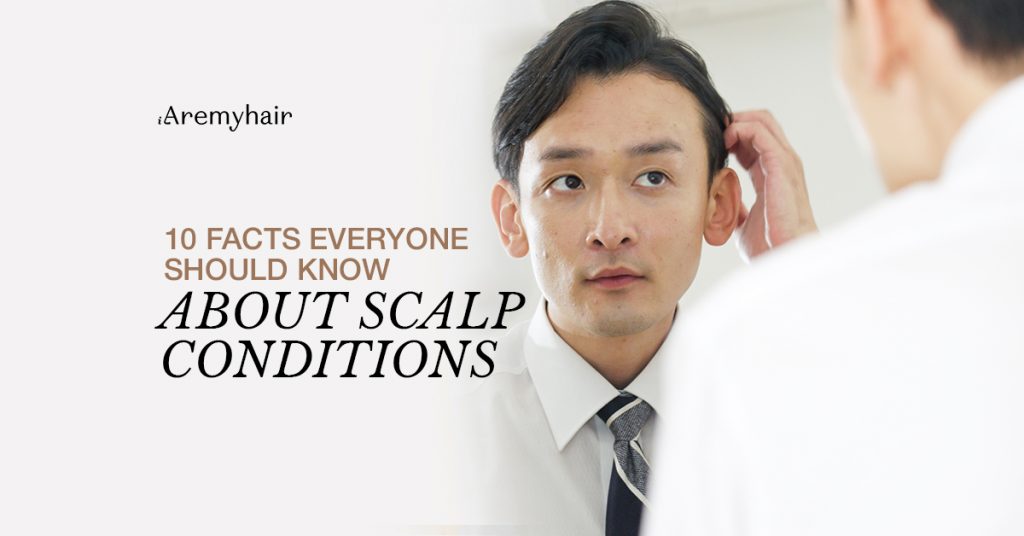While your crowning glory might seem like the most crucial part of your head, there’s more to the area than meets the eye. When you think of something going wrong with your body, your mind doesn’t immediately jump to problems with your scalp. But the truth is scalp conditions can cause problems worth looking into, from parasites to a flaky scalp and more.
The scalp is a very sensitive area of the body and can be susceptible to several conditions. So if you are experiencing problems with your scalp, it is a must to learn as much as possible about the various concerns that may affect this area.
The Scalp Is Unique Among Skin Areas
The scalp is a unique and complex skin area with a rich blood supply, is highly innervated, and contains numerous hair follicles. It also holds a high concentration of sebaceous glands, which produce sebum – an oily substance that helps to keep our skin and hair moisturised. The combination of these factors makes the scalp a difficult area to keep clean and healthy.
Due to the many crevices in between hair follicles where dirt can get trapped — grime, product buildup, bacteria, or fungi —are all prone to appear. As a result, the scalp can be affected by conditions like bacterial and fungal infections. But some conditions like seborrheic dermatitis, psoriasis, and alopecia areata are brought on by other factors like genetics and hormones.
Changes In Your Hair Could Indicate Nutrition And Health Issues
“You are what you eat” is a phrase we often hear, and it’s especially true when it comes to our hair. Your hair is a reflection of your overall health, so changes in your locks could be indicative of nutrition or health issues. Therefore, it’s essential to be aware of what to look out for. You can catch potential problems early by keeping an eye on your locks and addressing issues accordingly.
Changes in hair can include falling out, thinning, greying, and excessive oiliness or dryness. By understanding the possible causes of these changes, you can take steps to correct them and improve your overall health. So if you’re seeing changes in your locks, don’t brush them off – get to the root of the problem, literally!
The Psychological Impact Of Visible Scalp Problems Are High
The psychological effect of visual scalp problems has soared since hair plays a vital role in one’s appearance and sense of identity, especially in today’s society. For many, hair is a source of pride and individual style; for some, it is their only form of expression. Individuals with visible scalp problems may suffer from anxiety, depression, and low self-esteem. They may avoid social situations and feel isolated from others.
For example, people with lice or dandruff experience embarrassment and shame since others often associate these conditions with poor hygiene. And those who suffer from hair loss may isolate themselves or feel less confident interacting with others.
Here are 6 tips for hair loss prevention that actually work.
There Are Various Types Of Scalp Conditions
The scalp is an area that is sensitive to many different conditions. The most common problems are:
- Mycotic (fungal) conditions (dandruff, seborrheic dermatitis)
- Parasitic infections (head lice)
- Inflammatory conditions (Psoriasis and eczema)
Parasitic infections like head lice are pesky little pests that can be found on the head, eyebrows, and even in our eyelashes! They feed several times per day from our blood flow. These pests don’t spread any diseases, but they make it tough for those who have them because of the uncomfortable itchiness and even bruising on the scalp due to excessive scratching.
You can detect inflammatory conditions such as psoriasis and eczema if you see dry, scaly patches on the scalp, which may extend to other parts of the body. The causes of psoriasis and eczema involve genetics, environmental factors like smoking or stress, and an overactive immune system.
Dandruff And Seborrheic Dermatitis Are Very Common
Dandruff and seborrheic dermatitis are the two most common scalp conditions, affecting almost 50% of the world’s population. You can characterise dandruff if you see dry, flaky skin on the scalp, while seborrheic dermatitis is a more severe form of dandruff that can cause red, oily, and scaly skin. These conditions are caused by an overgrowth of a naturally-occurring fungus on the scalp. The difference is that dandruff occurs when dead skin cells build up faster from the scalp, while stress or hormones and cold weather often aggravate seborrheic dermatitis.
The Scalp’s Ringworm Is Caused By A Common Fungus
The most common fungal infection on the scalp is ringworm, and its symptom is a rash that appears as scaly, itchy patches. The fungus attacks the outer layer of skin on the scalp and the hair. While it does not damage hair follicles or cause baldness, ringworm can lead to permanent scarring if left untreated. Also, ringworms are highly contagious and can be spread through direct contact with an infected person or animal. Treatments for this scalp condition usually involve antifungal medication.
Many Types Of Scalp Conditions Share Similar Symptoms
It can be challenging to tell the difference between different scalp conditions because they often share similar symptoms. For example, dandruff and seborrheic dermatitis can cause scaly skin. Inflammatory conditions such as psoriasis and eczema cause redness, itchiness, and skin flaking.
However, some differences can help you identify which condition you may have. Knowing your family history is key when it comes to identifying scalp issues. For example, a hereditary condition called male pattern baldness affects a man’s hairline over time.
Hair Loss: Scarring Vs Non-Scarring
There are two types of hair loss: scarring and non-scarring. Scarring alopecia is a scalp condition caused by the permanent destruction of hair follicles due to inflammation and progressive collagen deposition. It is often associated with loss of sebaceous glands. A slow-cycling hair follicle stem cell may also play a role in the development of scarring hair loss.
Non-scarring hair loss includes conditions such as Alopecia Areata, where the follicles stop producing new hairs or Telogen Effluvium, where the hair falls out all at once due to physical stressors. Another non-scarring hair loss is Androgenetic Alopecia, which starts with a receding hairline that widens until it reaches a pattern on either side of the head and continues until there is a complete circle around the head.
Androgenetic Alopecia, A Scalp Condition Resulting In Hair Loss
Androgenetic Alopecia is the most common type of non-scarring condition. It affects nearly 50% of men and women, who usually begin to see signs by age 20-30; however, there are some whose onset may be later than these periods (in their 40s).
It is caused by genetics and hormones, resulting in thinning hair at the crown or temples. This condition typically begins at the temples or above both ears and progresses to form an M shape in men or towards the back of women’s heads.
Symptoms include increased oil production, scalp texture and colouration changes, premature greying, balding at the top of the head (the crown), and miniaturisation of hair follicles. While no cure exists, treatments are available to help slow the condition’s progression.
Read our ultimate guide to male pattern hair loss.
Treatments For Androgenetic Alopecia
While the name may sound daunting, scarring alopecia is treatable. Many treatments can help improve the scalp’s appearance and reduce hair loss. One of these treatment options is hair transplant surgery, which involves taking follicles from one part of the head and implanting them in bald or thinning areas.
Medications such as minoxidil (Rogaine) can also help stimulate hair growth. Other potential treatments include laser therapy and corticosteroid injections; these therapies will require multiple sessions over time before they are effective.
There are various options available when it comes to treating androgenetic alopecia. However, if you’re looking for a quick solution requiring little maintenance, consider investing in a hair replacement system.
The best part? You don’t need styling products because each unit contains 100% human hair, which looks like your actual locks. Hairpieces from Aremyhair can be your new crowning glory in just 90 minutes!
If you wish to talk to one of our specialists, call us TODAY at +65 6225 2022 or +65 9641 3620.








